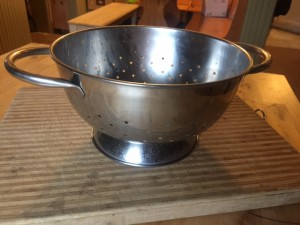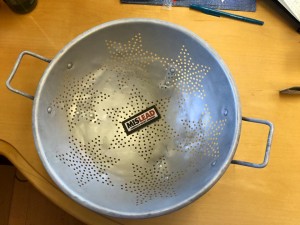Ask Tamara: Could you recommend a Lead-free colander?
For those new to this website:
Tamara Rubin is a multiple-federal-award-winning independent advocate for childhood Lead poisoning prevention and consumer goods safety, and a documentary filmmaker. She is also a mother of Lead-poisoned children (two of her sons were acutely Lead-poisoned in 2005). Since 2009, Tamara has been using XRF technology (a scientific method used by the U.S. Consumer Product Safety Commission) to test consumer goods for toxicants (specifically heavy metals — including Lead, Cadmium, Mercury, Antimony, and Arsenic). Tamara’s work was featured in Consumer Reports Magazine in February 2023 (March 2023 print edition).
This is an ad-free article!
Published: December 24, 2016
Updated: November 9, 2023
Question: Could you recommend a safe colander?
Answer: Many of my readers find me by following the Facebook page for my documentary film. While the film is not primarily about lead in consumer goods it does touch on that subject – so on that page I post pictures of items I have tested with an XRF instrument (read more here) along with the readings that I found for toxic heavy metals were in those items.
One item I have tested and shared recently is a common vintage household colander (pictured here). This specific vintage colander is probably similar to what your mother (or grandmother or great-grandmother – depending on how old you are!) may have had in their kitchen. The main problem with a lot of vintage cookware items is that they are obviously chalking, pitted or deteriorating in some way (from decades of heavy usage) and if they contain heavy metals (even traces of heavy metals) that could potentially get in to your food while cooking, that is a great concern.
This particular colander tested positive with an XRF for 26 parts per million (ppm) lead (very low and considered safe by all current standards for modern, newly manufactured cookware) and it also tested positive for 221 ppm cadmium.
While I am a lead expert and not a cadmium expert, I do know that cadmium is a toxic metal that has been shown to cause cancer even in trace amounts.
I will not go so far as to tell you that your particular vintage colander is going to poison you. To my knowledge there is no evidence to support this – specifically because no studies have been done on the impact of toxicant-containing vintage dishware on their users (who would fund such a study? Not the antique industry that’s for sure!). However I will state that from a philosophical and practical perspective neither lead nor cadmium belong in our cookware, in our kitchen or on our dining table – even in trace amounts.
As a result (especially given the age of this piece and the texture and pitting of the older bare metal) I would highly recommend replacing a vintage piece like this and not using it for cooking at all.

Here are some good options to take a look at if you are in the market for a new stainless colander for your kitchen! [Prices may have changed since I originally created this post.]
- This is similar to the one we have and is only $8.69
- Or you can get a set with four different sizes…(fun if kids are cooking with you!) $22.80
- For “Psych” fans… here’s one with a pineapple pattern for only $15.99!
- We also have one like this for rice (also just $16.95)
- This is one of my favorite kitchen tools [for rice and veggies and also washing toys – like legos over the sink – lol!] ($15.96)
Some of the links on this page may be affiliate links where a purchase made
after clicking will support this website without costing you extra!
There are a lot of great/ lead-safe options out there.
Things to avoid: Please get rid of/ stop using any plastic or aluminum strainers or colanders in your kitchen, especially if you regularly use them with hot or acidic foods. Also avoid colanders with any kind of coating, especially colored painted or enamel coatings or markings. Colors often are the source of heavy metals in our kitchenware and they colored coatings are the first part of the cookware to wear. While the coatings may test as “safe” by today’s standards when the item is manufactured there is no guarantee that they will remain safe once they start to wear (or after years of repeated use and washing.) Read more about that here. If you want bright and festive colors in your kitchen, make sure your food is bright and festive (fresh veggies and fruits) and maybe add a bouquet of flowers every now and then. Colorful cookware is not worth the risk.
Thank you for reading and for sharing the posts and articles here on Lead Safe Mama dot com! As always, please let me know if you have any questions. I will do my best to answer them personally as soon as I have a moment (although it may take a while – as I have disabled kiddos underfoot pretty much 24/7 these days!)
Tamara Rubin
Owner – Lead Safe Mama, LLC
Amazon links are affiliate links. If you purchase something after clicking on one of Lead Safe Mama, LLC’s affiliate links we may receive a percentage of what you spend at no extra cost to you.
Never Miss an Important Article Again!
Join our Email List











Hi,
I was wondering if the colander you put the link to on this article to buy are brands that you have tested- I want to order a brand that you’ve tested:)
The over-the-sink colander you recommended has rubber coverings on the handles. Have you tested those for lead before? There are a few similar products from different brands that I have been looking at but I am concerned about the rubber parts, as similar materials (e.g. in tools from OXO) have had lead.
Hi Jennifer, your telling me rubber handles have lead in them? Is this of concern? It never even touches the food. Sorry, I don’t know much about this stuff. I thought stainless steel colanders were pretty straight forward.
Hello,
I have purchased one of the colanders you recommend above which is ExcelSteel 242 5-Quart Stainless Steel Colander. The label says Made In China. I would like to make sure that if this is the right one you are recommending. Please let me know as soon as possible because I don’t want to use this if I received the wrong item.
Thank you!
Update: I just found out that the seller sent me the wrong colander which looks exactly like the one you are recommending, but the label says a different brand name and made in China. I am now in the process of return and refund. I will reorder the one you are recommending from another seller on amazon after the refund is done. I think we consumers need to be careful and make sure that a seller does not trick us with a wrong and unsafe product that looks just like the safe one Tamara recommends. I very much appreciate Tamara’s sincere and helpful work!
Thank you!
So is there also lead in plastic colanders? (“Please get rid of/ stop using any plastic or aluminum strainers or colanders in your kitchen, especially if you regularly use them with hot or acidic foods.”) Because I use Tupperware colanders, are they unsafe too?
Hi Camellia,
Tupperware colanders I have tested (new Tupperware) does not generally have Lead.
Tamara
Am wondering if you have tested and/or recommended a hand held stainless strainer. (Perhaps most good quality ones are safe to use.)
Hi Cheryl,
I am not exactly sure what you mean – but if it is ALL stainless, and sold by a name brand (and has no plastic or rubberized or painted components) – and also has no components made of other metals (like yellow brass), then it should be fine (from a Lead-perspective.
Tamara
Amazon no longer carries this colander. Can you recommend another one good for rice? Alkis Stainless Steel Colander Micro Perforated
Have you tested Duralex tempered glass products? It comes from France. I am looking for something to feed my cats on. I usually use small paper plates but Im looking for something reusable that is non toxic.
I am curious why rubberized or plastic components are a concern for lead.
Hi, I am purchasing a set of stainless steel mixing bowls (Vollrath brand). Is it generally true that new stainless steel kitchen items are typically lead free or do you recommend testing each brand? I don’t have any method to test at home. Thanks!
Are the barrington garage Berrybowks lead free? On site it says yes. ???
Berry bowls
Hi, I was wondering if it’s possible for silicone colanders (and dishes in general) to have lead?
It’s possible but they are more likely to have cadmium. If you do a search for silicone here on the blog you will see a lot of examples of items I have tested in that category. Here’s the video showing how to search the blog: https://tamararubin.com/2020/12/how-to-use-the-lead-safe-mama-website-video/
Here’s a good example: https://tamararubin.com/2019/04/whats-wrong-with-you-kitchenaid-kitchenaid-c-2010-yellow-silicone-spatula-970-29-ppm-lead-90-ppm-is-unsafe/
Tamara
Hello Tamara,
You recommend the ExcelSteel brand of strainer. Would you also recommend their mesh strainer? Made by the same company, just for use with smaller food.
Thank you
Is there stainless strainer (not colander, and not ‘over the sink’) that is heavy metals free?
Round, with one handle.
Like this https://www.amazon.com/YLYL-Strainer-Stainless-Strainers-Kitchen/dp/B08QN2XBHS/ref=sr_1_7
Preferably medium size mesh, and not fine mesh holes.
do you recommend any salad spinners?
The alkis collander is no longer available to purchase. Do you have a different recommendation for one you’ve tested?
Thanks!
Hello, none of the colanders you recommend are no longer available. Can you please give us some new safe suggestions?